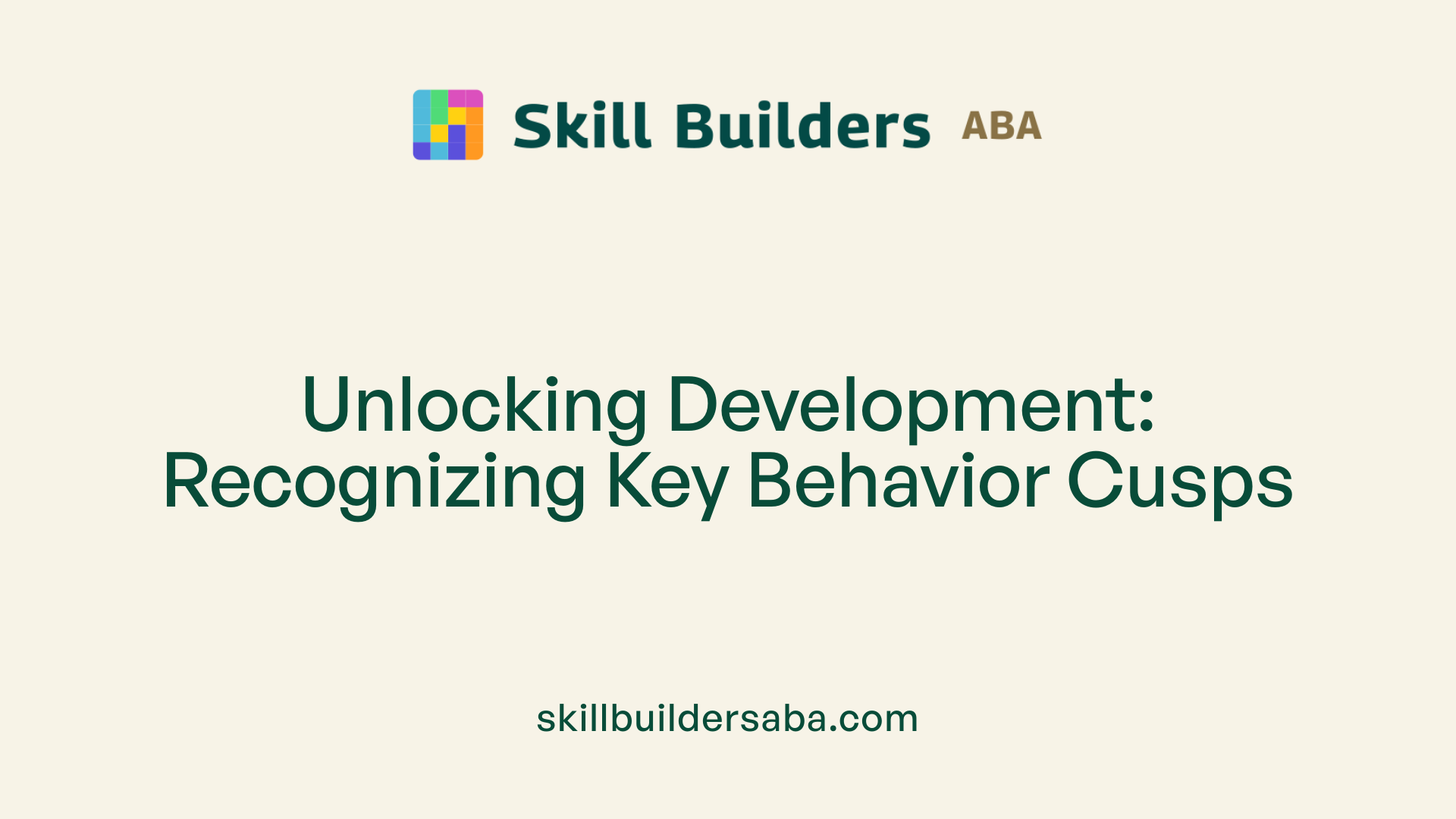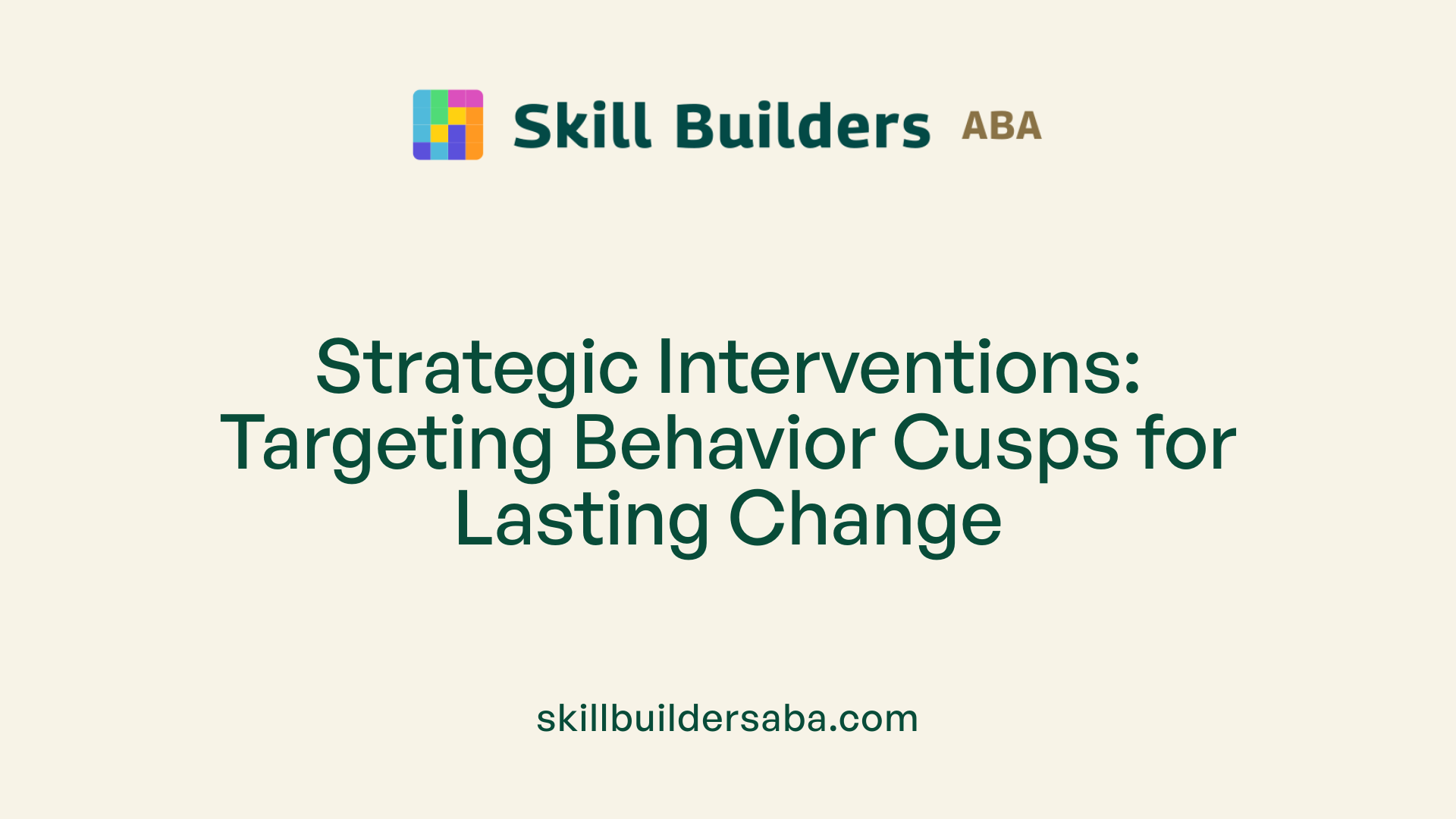
What are behavior cusps and why they matter
Unlocking Developmental Pathways: The Power of Behavior Cusps
Understanding Behavior Cusps and Their Impact on Development
Behavior cusps are pivotal behavioral changes that fundamentally alter an individual's interaction with their environment. Recognized within behavior analysis, these behaviors serve as gateways to new opportunities, skills, and social engagement, influencing both short-term capabilities and long-term developmental trajectories.
Defining Behavior Cusps and Their Significance in Development

What is a behavior cusp?
A behavior cusp is a crucial behavioral change that provides an individual access to new environments, reinforcers, and opportunities for learning and interaction. It fundamentally alters how a person engages with their surroundings, often leading to widespread and long-lasting developmental benefits. A cusp acts as a gateway, allowing the individual to experience new contingencies and acquire additional skills without requiring explicit instruction.
For example, when a baby learns to crawl, they gain access to new physical spaces and social interactions that were previously unavailable. Similarly, teaching a child to use a communication device opens avenues for expressing needs and participating more actively in social settings. These behaviors are not just isolated skills; they catalyze further growth and development, impacting multiple areas of functioning.
How does a behavior cusp impact development?
The influence of behavioral cusps on development is profound and far-reaching. Once activated, they lead to a cascade of new behaviors, broadening an individual's repertoire and enhancing adaptive functioning. These behaviors facilitate engagement with complex environments, foster social participation, and enable learning of more advanced skills.
Cusps often occur naturally, such as infants crawling or walking, but can also be introduced intentionally through targeted interventions. Their significance lies in their ability to unlock new social, cognitive, and physical opportunities, fostering independence and confidence.
In developmental contexts, behavioral cusps serve as pivotal points that shape future trajectories. They support generalization of skills across different settings and contribute to overall growth. Recognizing and targeting these behaviors in therapeutic or educational programs can lead to transformative improvements in a person's quality of life.
Ultimately, understanding and leveraging behavioral cusps are essential for designing effective developmentally appropriate interventions that promote lifelong learning and adaptation.
Identifying and Characterizing Behavior Cusps

How are behavior cusps identified?
Behavioral cusps are distinguished by their profound influence on an individual's behavioral development. They are identified through their ability to enable contact with new environmental contingencies and reinforcers, which further promotes learning and growth.
To recognize a cusp, practitioners evaluate whether the behavior change leads to broad, collateral increases in other untrained behaviors or opens access to new social or learning opportunities. Empirical measurement is crucial — for example, observing whether a new skill, like crawling, results in the child gaining access to new environments and reinforcement sources. Furthermore, from a developmental perspective, researchers assess if the original change fosters subsequent complex behaviors, such as walking or language development. This causal, often nonlinear impact makes cusps stand out in behavior analysis.
Key features of behavioral cusps
Behavioral cusps have several distinct features that set them apart:
- Transformative Impact: Cusps facilitate access to new reinforcers and contingencies, resulting in widespread behavioral changes.
- Causal and Nonlinear: Their effects are often large and non-sequential, causing disproportionate developmental shifts.
- Empirically Validated: Identification relies on observable contact with new contingencies after the behavior change, not merely assumption.
- Functional Significance: They are selected based on their social or developmental relevance and capacity to generate further advances.
- Generativity: Cusps enable learning of new skills that can be recombined or generalized across contexts.
- Influence on Others: They can impact not only the individual but also their social environment, including caregivers and teachers.
In summary, recognizing a behavioral cusp involves observing a behavior that leads to a marked expansion of opportunities for reinforcement and development. Their identification is rooted in empirical evidence, with a focus on their capacity to instigate broad, meaningful change in behavior trajectories.
Role of Behavioral Cusps in Analysis and Intervention
What role do behavior cusps play in behavioral analysis and assessment?
Behavioral cusps are vital in the field of behavioral analysis because they mark moments when an individual gains access to new environments and contingencies, profoundly impacting development and learning. These behaviors serve as gateways, enabling broader participation in social, educational, and daily activities.
In assessments, revealing potential cusps helps practitioners identify which behaviors to target for intervention. Tools like the VB-MAPP, ABLLS-R, and comprehensive ecological evaluations assist in pinpointing behaviors that, once learned, could lead to extensive developmental gains.
Targeting cusps in intervention strategies enhances the likelihood of achieving widespread positive changes. For example, teaching a child to initiate communication not only improves social interaction but also opens doors to new learning opportunities and community involvement.
Moreover, identifying behaviors with cusp potential ensures that interventions are efficient and impactful, helping individuals attain greater independence and social engagement. Recognizing the importance of these behaviors helps practitioners design more meaningful and functional programs.
How are cusps used in assessment and intervention?
In practice, behavioral interventions focus on teaching behaviors that qualify as cusps because of their capacity to create cascading improvements. For example, helping a non-verbal child learn to use a communication device falls under targeting a cusp, offering access to expressive language and social participation.
Assessment protocols include evaluating which behaviors are likely to serve as cusps by examining their social validity, generativeness, and potential to influence multiple other behaviors. Once identified, these behaviors become central targets for intervention.
Interventions designed around cusps often result in collateral behavioral growth — signs of broader development that go beyond the directly taught skill. For instance, teaching a child to walk might lead to spontaneous exploration and interaction, not explicitly planned.
In summary, the use of behavioral cusps in assessment and intervention provides a strategic focus for creating lasting, meaningful improvements in individuals’ functioning, leveraging the natural propensity for behaviors that open avenues for further development.
Behavior Cusps in Developmental and Educational Contexts

Why are behavior cusps relevant in developmental behavior?
Behavior cusps play a crucial role in development because they mark pivotal moments when a person gains access to new environments, reinforcers, and social interactions. These behavior changes are not isolated; instead, they create pathways for further learning and skill acquisition. For example, when a child begins to crawl, they can explore more of their surroundings, which can lead to new opportunities for social engagement, problem-solving, and motor development.
These cusps influence the individual’s entire developmental trajectory by exposing them to new contingencies that promote broader behavioral improvements. They facilitate the generalization of skills, enabling behaviors learned in one context to be transferred to others. This generativity makes behavior cusps particularly valuable targets in intervention programs, especially for children with developmental challenges, such as autism. By focusing on producing these pivotal behavior changes, educators and therapists can open doors to more complex and adaptive behaviors, supporting long-term growth.
In summary, behavioral cusps are vital because they set the stage for subsequent development. They create opportunities for new learning, foster independence, and help shape a more comprehensive behavioral repertoire. Understanding and targeting these points in development can lead to meaningful and sustainable progress in both natural settings and therapeutic interventions.
Examples and Differentiation of Behavior Cusps and Pivotal Behaviors

What are some examples of behavior cusps?
Behavior cusps are specific behaviors that, once learned, provide access to new environments, reinforcers, and social or learning opportunities. These behaviors have a profound impact because they open doors to further development.
For example, crawling is a classic cusp in infants. When a baby learns to crawl, they can explore new spaces, access different stimuli, and engage with the environment in ways that weren't possible before. This behavior increases opportunities for sensory input, social interaction, and even mobility.
In the realm of communication, teaching a child with autism to use a communication device exemplifies a cusp. It enables the child to express needs, participate in conversations, and build social relationships that were previously inaccessible.
Wider developmental behaviors such as learning to read fluently also qualify as cusps. Fluency in reading not only opens access to knowledge but also supports other academic and social skills.
Pivotal behaviors, like initiating social interactions or brushing teeth regularly, also induce broad changes. When a child begins engaging in social communication or takes responsibility for self-care, these skills tend to lead to multiple improvements across everyday behavior.
Overall, behavior cusps are pivotal because they dramatically broaden an individual's environmental contacts and learning opportunities, supporting continuous growth.
How do behavior cusps differ from pivotal behaviors?
While both concepts relate to significant behavior change, their focus and outcomes differ distinctly.
Behavioral cusps are behaviors that, once attained, unveil new environments, reinforcers, and contingency opportunities. They act as gateways, expanding an individual's world. For instance, learning to walk allows participation in social and recreational activities previously inaccessible, increasing experiential learning.
Conversely, pivotal behaviors are broader skills that trigger widespread, often untrained, improvements in various behaviors. These behaviors tend to influence multiple developmental domains. An example is a child's ability to initiate social interactions; once this skill is learned, it can lead to enhancements in communication, peer relationships, and confidence.
The main difference is that cusps primarily provide access to new contexts and stimuli, whereas pivotal behaviors produce extensive, cascading changes across numerous behaviors.
In summary, a cusp such as learning to read, broadens horizons and opens new learning pathways. In contrast, a pivotal skill like social initiation underpins broad developmental improvements, generally leading to a more comprehensive behavioral enhancement without necessarily opening new environments.
Understanding these differences helps in designing targeted interventions: focusing on cusps can expand opportunities and access, while targeting pivotal behaviors can foster overall adaptive functioning.
Application of Behavior Cusps in Interventions and Outcomes

Why is targeting behavior cusps important in intervention programs?
Focusing on behavior cusps in interventions is a strategic approach to foster significant developmental progress. These behaviors act as gateways, granting access to new environments, reinforcers, and social opportunities. When an individual acquires a cusp, it can lead to broad and often rapid changes across multiple areas of functioning.
Because cusps are nonlinear and have far-reaching consequences, they often trigger the contact with new reinforcement contingencies and communities. This can result in the spontaneous emergence of additional skills without direct teaching.
For example, teaching a child to use a communication device can open doors to social interaction and learning. Similarly, developing the ability to walk allows participation in social activities that were previously inaccessible.
Incorporating these behaviors into intervention plans creates ripple effects, enhancing communication, social engagement, independence, and learning.
What are the functions of behavior in ABA?
In Applied Behavior Analysis (ABA), understanding the functions of behavior is crucial. The primary functions include gaining attention, escaping demands, accessing tangible items, and self-stimulation. Recognizing these functions helps to develop appropriate interventions that address the underlying reasons for certain behaviors.
By identifying whether a behavior is a cusp—meaning it provides access to new environmental contingencies—therapists can design strategies that promote such pivotal behaviors. This supports generativity, allowing the individual to develop a wider repertoire of skills and responses.
When targeting behavioral cusps, interventions aim to produce widespread collateral changes, leading to more meaningful and durable development. This approach is particularly valuable for individuals with autism, where promoting access to new reinforcers and environments can have a profound impact on overall growth.
| Aspect | Explanation | Example |
|---|---|---|
| Significance | Behaviors that open access to new opportunities | Learning to read fluently enabling further learning |
| Functionality | Contact with new contingencies and reinforcement | Baby crawling, which leads to new exploration |
| Impact | Broad developmental effects | Initiating social interactions improving language skills |
Understanding these elements enhances the design of targeted interventions, ensuring they are effective and socially valid. Emphasizing behavioral cusps in therapy supports individuals in achieving independence and meaningful engagement in their communities.
The Far-Reaching Impact of Behavior Cusps
Behavior cusps are fundamental to understanding and facilitating development through behavior analysis. By identifying and targeting these behaviors, practitioners can unlock significant growth opportunities that influence the entire behavioral repertoire of an individual. The nonlinear and generative nature of cusps makes them powerful tools in intervention, fostering independence, social participation, and adaptive functioning. Their pivotal role in developmental, educational, and clinical settings underscores the importance of a strategic focus on behavioral cusps for fostering meaningful and lasting change.
References
- Understanding Behavior Cusps and Pivotal Behaviors in ABA
- a developmental and pragmatic concept for behavior analysis - PMC
- [PDF] Rosales-Ruiz 1997 Behavioral Cusps
- What Is A Cusp?
- Behavior Cusp for Success - Astra ABA
- Advancing and Integrating the Cusp Concept to Understand ...
- A developmental and pragmatic concept for behavior analysis
- [PDF] The Final Piece to a Complete Science of Behavior Behavior ... - ERIC
- Behavior Cusp - Study Notes ABA
Clear Answers for Caring Parents
You can find a detailed breakdown of our programs on our website. If you prefer to skip the reading and have a conversation about what’s possible, feel free to reach out to us today.
Reach Out Today
Learn more about how we can support your child’s growth and development. Contact us to discuss our services and availability in your area.
.svg)